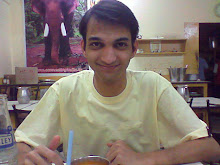Tuesday, December 2, 2008
A Logic for Compensation Package
Thursday, October 9, 2008
Some Models for Dowry Calculation
Sunday, October 5, 2008
The US Financial Crisis - How am I affected?
Saturday, October 4, 2008
Self - Orientation Model of Leadership - An alternative thought
Thursday, August 14, 2008
Leadership Lessons from A Road to Freedom - The Dandi March (1930)

Sunday, August 10, 2008
The Fall of Religion - A Look & Some Questions...
Watching the video above, three significant questions with viewpoints come into my mind. I state them below.
1- What indeed is "rationalism"? Sanal Edamaruku did a commendable job in attacking the tantrik. Religion is this country is so paradoxical with conflicting ideas and values. It focuses only at one place - peace of the mind through the dissapearance of money from the pockets. According to me Science should be the only religion and recognition of the principle and action of Atom behind every process must be the path to Spirit. Practicing it will not only prove the Vedic saying that "God is one" but also helps us to recognise and use the power for a constructive purpose. For a detailed discussion do read my blog - Is Atom God?
2- Coming to the tantrik, the very fact that he challenged to kill Sanal LIVE reflected three major flaws of his personality.
a- He does not value human life; while the mantras were aimed for upliftment of the same through purification and expansion of mind. It brings about a serious reflection that what "type" of people are actually using, rather abusing, these sciences. Mind you, I still call them sciences. Every scientific law works in a particular context (for example the gravitational constant in earth will not be acceptable in moon). So was there an appropriate preparation of context in this case? How much of knowledge do we know to even negate it? It failed because it was in the wrong hands, used wrongly and with wrong intentions in an inappropriate context. Serious research is necessary to obtain the guidelines for effective implementation of tantra vidya. And moreover, tantra vidya is for personal purification and so are siddhis and they will certainly fail when abused with no respect for others and aimed for self-glorification.
b- How many tantriks actually do their mumbo-jumbo in the physical prescence of their victims? To the best of my knowledge they do a back-ground job. Then why did this person touch Sanal and make him touch his stuff? Is he not a charlatan of the first order?
c- The tantrik has no faith on his knowledge or else mantras do not require physical prescence. Mantras are supposed to be vibrations and vibrations are waves which travel based on initiating force and the source of the force. The tantrik sounds so drunk, how can the vibration be effective?
3- Last but not the least, based on the video, one cannot refute the existence of "spritualism" . Rationality cannot be anti-spirituality. Rather its the best way and a short cut to the Spirit since many of these unmeaningful rituals can be bypassed. Spirituality is not religion with its mumbo-jumbo, but one has to really sit and define what indeed is spirituality. According to me its the greatest science - a science of "self enquiry", but what is the process? Though we say there are many alternative path to spirit, yet I argue there is NOT! It has to be one glorious path for scientific laws are self-contained in themselves. Since spirituality is a science, the laws of it has to be well-defined and unchangable. However, sadly many of us are unaware. Its for nothing that young men and women have left households to Himalayas. Surely there must be a stronger motivational force to pull them away from the earthly pleasures of wine, women and money so freely available in the plains. Were they aware of those laws or did they leave in the search of those laws? If its the later, then its a really long journey. What is that "force" that pulled them out of their homes and why is it not equally attractive to all? And what does it guarentee on achievement? Till we define that (which soon we must !) we will be at the mercy of such charlatans and hence must boldly declare -Atom is God !
Sunday, July 27, 2008
My Freedom and My Fate...A Debate !
Having defined God and visualization previously, one can define Grace too.
Grace can be defined as a motivation that is transmitted from a person having total visualization to a person having limited visualization to act in a desired manner in order to propell a faster and beneficial decision making for the later. Since most of us have limited vision, we have to call upon God (the person having maximum visualization) to see where our plans have gone wary or can go wrong. Since He is trikaldarshi, the knower of past, present and future, He guides yet never forces us to decisions. A mistake is allowed and many ways are given to come back to the main plan. But still mistakes are allowed. God has the power to limit our choices to a few to enable us to succeed if only we trust on His vision. However He is the greatest democrat. He allows us to have it our own way, yet He is there at your beck and call. Thats why Jesus said, 'Ask, and it shall be Given, Knock and the door shall be opened'. Hence the only free-will that we have is Trust God or trust Self !
